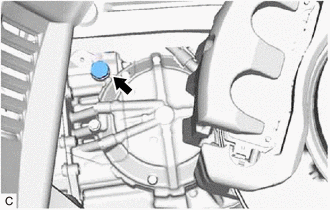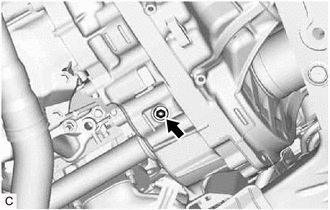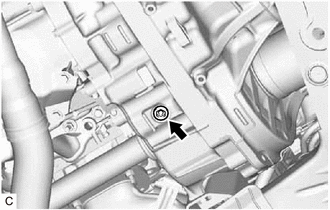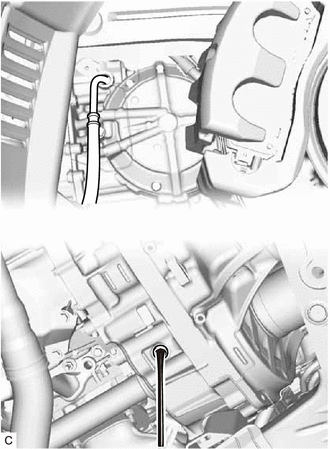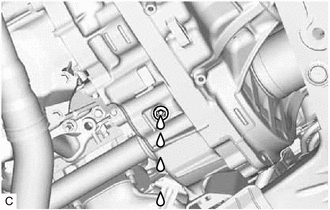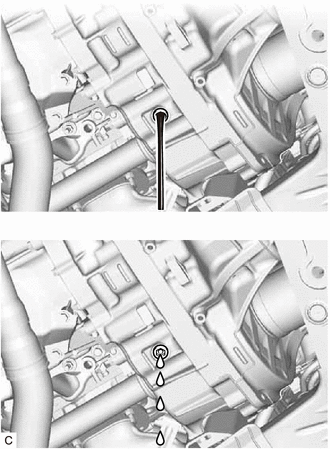Lexus RX (RX 350L, RX450h) 2016-2025 Repair Manual: Adjustment
ADJUSTMENT
PROCEDURE
1. PRECAUTIONS AND WORK DESCRIPTION
(a) The U881E automatic transaxle assembly does not have an oil filler tube and oil level gauge. When adding automatic transaxle fluid, add automatic transaxle fluid through the refill hole on the automatic transaxle case sub-assembly. The automatic transaxle fluid level can be adjusted by draining excess automatic transaxle fluid (allowing excess automatic transaxle fluid to overflow) through the overflow plug of the transaxle housing.
HINT:
"Overflow" indicates the condition under which automatic transaxle fluid comes out of the overflow plug hole.
(b) Before adjusting the automatic transaxle fluid level, add the specified amount of automatic transaxle fluid when the engine is cold and warm up the engine to circulate the automatic transaxle fluid in the automatic transaxle assembly. Ensure that the automatic transaxle fluid temperature is as specified and the engine is idling.
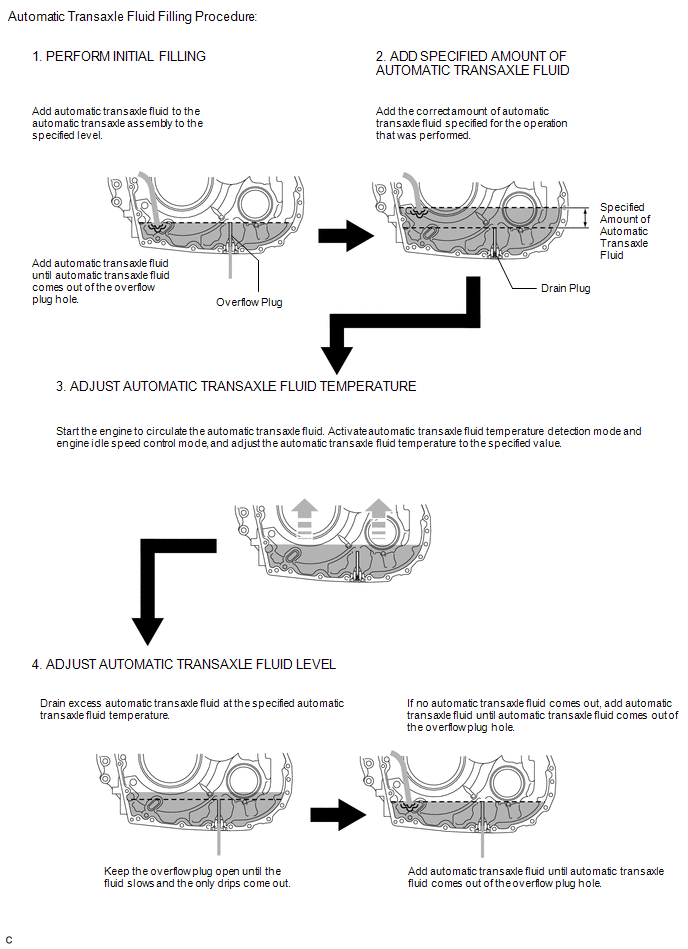
(c) The U881E automatic transaxle assembly requires Toyota Genuine ATF WS.
(d) The adjustment should be performed according to the procedures and notes.
2. WORK FLOW
(a) The adjustment should be performed according to the procedure referenced in the work flow below.
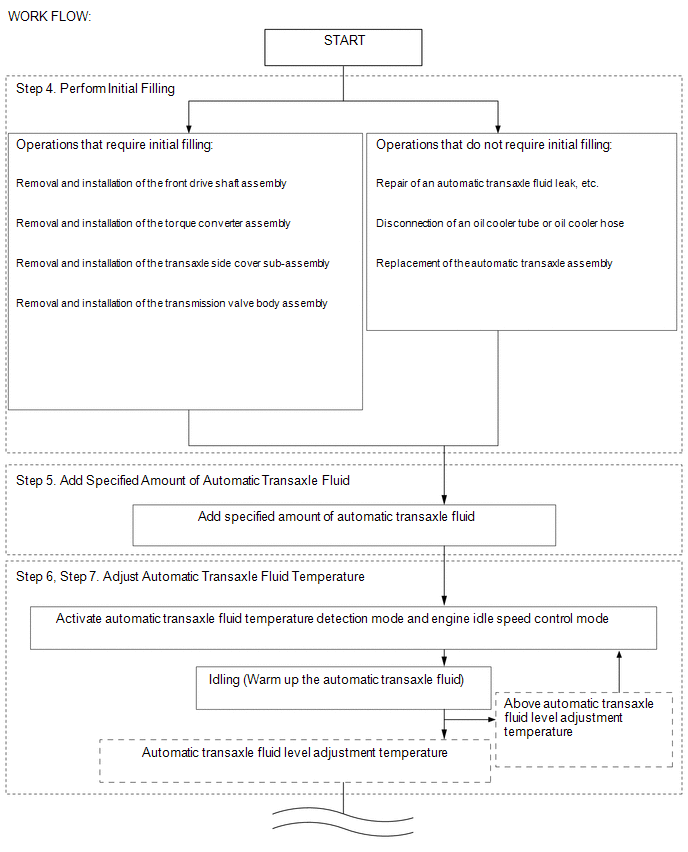
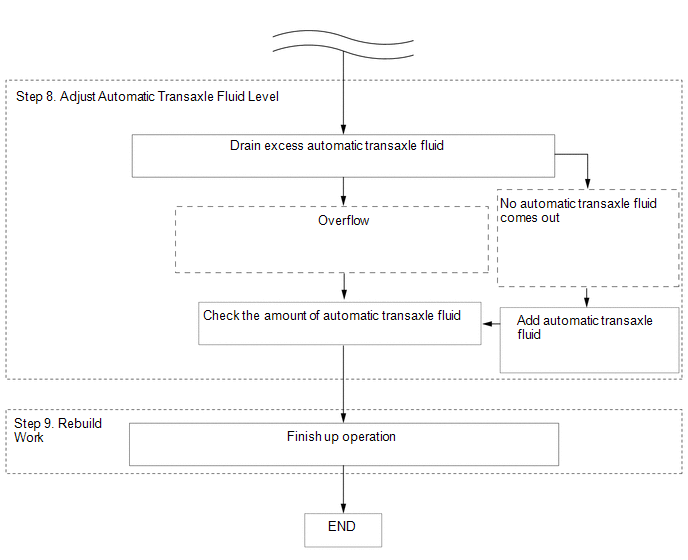
3. PREPARATION WORK
(a) Lift the vehicle.
NOTICE:
Set the vehicle on a lift so that the vehicle is kept level when it is lifted up (make sure that the tilt angle from the front to rear of the vehicle is within +/- 1°).
(b) Remove the front wheel opening extension pad LH.
Click here .gif)
(c) Remove the No. 3 engine under cover.
Click here .gif)
(d) Remove the front fender apron seal LH.
Click here .gif)
4. PERFORM INITIAL FILLING
NOTICE:
If the automatic transaxle assembly is hot (ATF temperature is high), wait until the automatic transaxle fluid temperature becomes the same as the ambient temperature before starting the following procedure. (Recommended ATF temperature: around 20°C (68°F))
| (a) Remove the refill plug and gasket from the automatic transaxle case sub-assembly. NOTICE: After performing either of the following operations, it is not necessary to perform the initial filling procedure. Proceed to the "Add Specified Amount of Automatic Transaxle Fluid" procedure.
|
|
| (b) Using a T40 "TORX" socket wrench, remove the drain plug and O-ring from the transaxle housing. NOTICE:
|
|
| (c) Using a 17 mm straight hexagon wrench, check that the overflow plug is tightened to the specified torque. Torque: 47 N·m {479 kgf·cm, 35 ft·lbf} NOTICE: If the overflow plug is not tightened to the specified torque, the amount of automatic transaxle fluid cannot be precisely adjusted. |
|
(d) Perform initial filling.
| (1) Fill the automatic transaxle assembly through the refill hole until automatic transaxle fluid begins to come out of the overflow plug hole. NOTICE: Use Toyota Genuine ATF WS. |
|
| (e) Wait until the automatic transaxle fluid flow slows and only drips come out. |
|
| (f) Using a T40 "TORX" socket wrench, temporarily install the O-ring and drain plug to the transaxle housing. HINT: Reuse the old O-ring as the drain plug will be removed again to adjust the automatic transaxle fluid level. |
|
5. ADD SPECIFIED AMOUNT OF AUTOMATIC TRANSAXLE FLUID
(a) Fill the automatic transaxle assembly with the correct amount of automatic transaxle fluid as listed in the table below.
NOTICE:
The volume of automatic transaxle fluid to be added depends on the operation that was performed.
Reference Capacity:
| Performed Repair | Fill Amount |
|---|---|
| Automatic transaxle assembly replacement (with a new torque converter assembly) | 4.2 liters (4.4 US qts, 3.7 Imp. qts) |
| Automatic transaxle assembly replacement (when reusing the torque converter assembly) | 3.0 liters (3.2 US qts, 2.6 Imp. qts) |
| Removal and installation of the transaxle side cover sub-assembly or oil drainage | 3.0 liters (3.2 US qts, 2.6 Imp. qts) |
| Replacement of a front drive shaft assembly | 3.0 liters (3.2 US qts, 2.6 Imp. qts) |
| Removal and installation of the transmission valve body assembly | 3.0 liters (3.2 US qts, 2.6 Imp. qts) |
| Replacement of the torque converter assembly | 3.0 liters (3.2 US qts, 2.6 Imp. qts) |
| Any operation where a small amount of oil is drained | 0.5 liters (0.5 US qts, 0.4 Imp. qts) |
| (b) Temporarily install the gasket and refill plug to avoid automatic transaxle fluid spillage. HINT: Reuse the old gasket as the refill plug will be removed again to adjust the automatic transaxle fluid level. |
|
(c) Lower the vehicle.
6. ADJUST AUTOMATIC TRANSAXLE FLUID TEMPERATURE (when Using the Techstream)
HINT:
The actual ATF temperature can be checked on the Data List using the Techstream.
(a) Connect the Techstream to the DLC3 with the engine switch off.
(b) Turn the engine switch on (IG) and turn the Techstream on.
NOTICE:
To reduce load, make sure that all electrical systems, such as the air conditioning, lighting system, electric fan and audio system, are off.
(c) Enter the following menus: Powertrain / Transmission / Active Test / Activate the TC Terminal
Powertrain > Transmission > Active Test| Active Test Display |
|---|
| Activate the TC Terminal |
| Data List Display |
|---|
| A/T Oil Temperature No.1 |
(d) According to the display on the Techstream, perform the Data List "A/T Oil Temperature No. 1".
(e) According to the display on the Techstream, perform the Active Test "Activate the TC Terminal / ON".
(f) Check the ATF temperature.
NOTICE:
- If the automatic transaxle fluid temperature is below 35 °C (95 °F), proceed to the next step. Recommended ATF temperature: 40°C (104°F) or less
- If the automatic transaxle fluid temperature is 45°C (113°F) or more, turn the engine switch off and wait until the automatic transaxle fluid temperature drops below 45°C (113°F).
(g) Depress and hold the brake pedal.
(h) Start the engine.
(i) Slowly move the shift lever from P to D, then back to P (keep the shift lever in each position for approximately 3 seconds).
HINT:
Slowly move the shift lever to circulate the automatic transaxle fluid through each part of the automatic transaxle assembly.
(j) While observing the D shift indicator on the combination meter, move the shift lever back and forth between N and D at an interval of less than 1.5 seconds for 6 seconds or more.
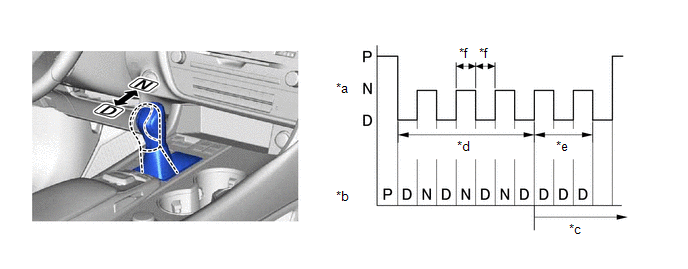
| *a | Shift Position | *b | Indication of Shift Position |
| *c | Fluid Temperature Detection Mode | *d | 6 sec. or more |
| *e | 2 sec. | *f | Less than 1.5 sec. |
NOTICE:
Do not pause for more than 1.5 seconds.
HINT:
Performing this operation will cause the vehicle to enter automatic transaxle fluid temperature detection mode.
(k) Check that the D shift indicator comes on for 2 seconds.
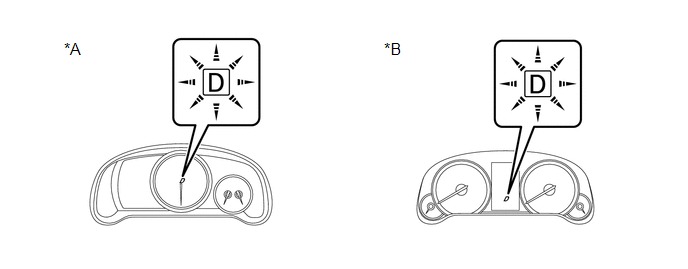
| *A | for TFT Meter Type | *B | for Optitron Meter Type |
HINT:
- When automatic transaxle fluid temperature detection mode is activated, the D shift indicator on the combination meter comes on for 2 seconds.
- If the D shift indicator does not come on for 2 seconds, return to the first step (perform the Active Test "Activate the TC Terminal / ON") and perform the procedure again.
(l) Move the shift lever to P.
(m) Release the brake pedal.
(n) According to the display on the Techstream, perform the Active Test "Activate the TC Terminal / OFF".
NOTICE:
Make sure that the terminals are not connected. If the terminals are connected, the automatic transaxle fluid level cannot be precisely adjusted due to fluctuations in engine speed.
HINT:
- Disconnecting the terminals activates engine idle speed control mode.
- In engine idle speed control mode, engine idle speed control starts when the automatic transaxle fluid temperature reaches the specified temperature and the engine speed is maintained.
- Even after the terminals are disconnected, automatic transaxle fluid temperature detection mode is active until the engine switch is turned off.
(o) Adjust the automatic transaxle fluid temperature to the automatic transaxle fluid level adjustment temperature.
Automatic Transaxle Oil Temperature| Below Automatic Transaxle Fluid Level Adjustment Temperature | Automatic Transaxle Fluid Level Adjustment Temperature | Above Automatic Transaxle Fluid Level Adjustment Temperature |
| (35°C or less) (95°F or less) | (35 to 45°C) (95 to 113°F) | (45°C or more) (113°F or more) |
NOTICE:
- If the automatic transaxle fluid temperature is within the automatic transaxle fluid level adjustment temperature range, immediately proceed to the "Adjust Fluid Level" procedure.
- If the automatic transaxle fluid temperature is 45°C (113°F) or more, stop the engine and wait until the automatic transaxle fluid temperature drops to 35 °C (95 °F) or less. Then perform the "Adjust Automatic Transaxle Fluid Temperature" procedure again from the beginning.
HINT:
In automatic transaxle fluid temperature detection mode, the D shift indicator comes on, goes off or blinks depending on the automatic transaxle fluid temperature.
D Shift Indicator| Below Automatic Transaxle Fluid Level Adjustment Temperature (35°C or less) (95°F or less) | Automatic Transaxle Fluid Level Adjustment Temperature (35 to 45°C) (95 to 113°F) | Above Automatic Transaxle Fluid Level Adjustment Temperature (45°C or more) (113°F or more) |
| OFF | ON | Blinks |
7. ADJUST AUTOMATIC TRANSAXLE FLUID TEMPERATURE (when Not Using the Techstream)
(a) Turn the engine switch off.
(b) Depress and hold the brake pedal.
(c) Start the engine. [#1]
NOTICE:
To reduce load, make sure that all electrical systems, such as the air conditioning, lighting system, electric fan and audio system are off.
(d) Slowly move the shift lever from P to D, then back to P (keep the shift lever in each position for approximately 3 seconds). [#2]
HINT:
Slowly move the shift lever to circulate the automatic transaxle fluid through each part of the automatic transaxle assembly.
(e) While observing the D shift indicator on the combination meter, move the shift lever back and forth between N and D at an interval of less than 1.5 seconds for 12 seconds or more. [#3]

| *a | Shift Position | *b | Indication of Shift Position |
| *c | Fluid Temperature Detection Mode | *d | 12 sec. or more |
| *e | 2 sec. | *f | Less than 1.5 sec. |
NOTICE:
Do not pause for more than 1.5 seconds.
HINT:
- Performing this operation will cause the vehicle to enter fluid temperature detection mode and engine idle speed control mode.
- In engine idle speed control mode, engine idle speed control starts when the automatic transaxle fluid temperature reaches the specified temperature and the engine speed is maintained.
- Perform [#1] to [#3] within 60 seconds.
(f) Check that the D shift indicator comes on for 2 seconds.

| *A | for TFT Meter Type | *B | for Optitron Meter Type |
HINT:
- When automatic transaxle fluid temperature detection mode is activated, the D shift indicator on the combination meter comes on for 2 seconds.
- If the D shift indicator does not come on for 2 seconds, return to the first step and perform the procedure again.
- Automatic transaxle fluid temperature detection mode is active until the engine switch is turned off.
(g) Move the shift lever from N to P.
(h) Release the brake pedal.
(i) Allow the engine to idle until the D shift indicator comes on again.
D Shift Indicator| Below Automatic Transaxle Fluid Level Adjustment Temperature (35°C or less) (95°F or less) | Automatic Transaxle Fluid Level Adjustment Temperature (35 to 45°C) (95 to 113°F) | Above Automatic Transaxle Fluid Level Adjustment Temperature (45°C or more) (113°F or more) |
| OFF | ON | Blinks |
NOTICE:
- If the D shift indicator is on, immediately proceed to the "Adjust Automatic Transaxle Fluid Level" procedure.
- If the D shift indicator blinks, stop the engine and wait until the automatic transaxle fluid temperature drops to 35 °C (95 °F) or less (the indicator goes off). Then perform the "Adjust Automatic Transaxle Fluid Temperature" procedure again from the beginning.
HINT:
- In automatic transaxle fluid temperature detection mode, the D shift indicator comes on, goes off, or blinks depending on the automatic transaxle fluid temperature.
- Automatic transaxle fluid filling procedure should be performed when the D shift indicator is on (the automatic transaxle fluid temperature is within the automatic transaxle fluid level adjustment temperature range).
8. ADJUST AUTOMATIC TRANSAXLE FLUID LEVEL
CAUTION:
Use caution while the engine is idling and the radiator fans are operating.
(a) Lift the vehicle.
NOTICE:
Set the vehicle on a lift so that the vehicle is kept level when it is lifted up (make sure the tilt angle from the front to rear of the vehicle is within +/- 1°).
| (b) Using a T40 "TORX" socket wrench, remove the drain plug and O-ring from the transaxle housing. CAUTION: Be careful as the automatic transaxle fluid coming out of the drain plug hole is hot. |
|
(c) Check the amount of automatic transaxle fluid that comes out of the drain plug hole.
- If the amount of automatic transaxle fluid that comes out of the overflow plug hole is large, proceed to step [*1].
- If no automatic transaxle fluid comes out of the overflow plug hole, proceed to step [*2].
NOTICE:
If only a small amount of automatic transaxle fluid (approximately 1 cc) comes out of the overflow plug hole, then only automatic transaxle fluid remaining in the overflow plug has come out. This condition is not considered as overflow, so it is necessary to add automatic transaxle fluid.
(d) If the amount of automatic transaxle fluid that comes out of the drain plug hole is large. [*1]
| (1) Wait until the automatic transaxle fluid flow slows and only drips come out. HINT: The automatic transaxle fluid flow will not stop completely because the automatic transaxle fluid continues to expand as its temperature increases. |
|
(e) If no automatic transaxle fluid comes out of the drain plug hole. [*2]
| (1) Remove the refill plug and gasket from the automatic transaxle case sub-assembly. |
|
| (2) Then add automatic transaxle fluid through the refill hole until automatic transaxle fluid comes out of the drain plug hole. NOTICE: Use Toyota Genuine ATF WS. |
|
| (3) Wait until the automatic transaxle fluid flow slows and only drips come out. |
|
| (f) Using a T40 "TORX" socket wrench, install the drain plug and a new O-ring to the transaxle housing. Torque: 7.4 N·m {75 kgf·cm, 65 in·lbf} |
|
| (g) Install the refill plug and a new gasket to the automatic transaxle case sub-assembly. Torque: 49 N·m {500 kgf·cm, 36 ft·lbf} |
|
(h) Lower the vehicle.
(i) Turn the engine switch off.
HINT:
Turning the engine switch off ends automatic transaxle fluid temperature detection mode.
(j) Disconnect the Techstream from the DLC3 (when using the Techstream).
9. REBUILD WORK
(a) Lift the vehicle.
(b) Clean each part.
(c) Check for automatic transaxle fluid leaks.
(d) Install the front fender apron seal LH.
Click here .gif)
(e) Install the No. 3 engine under cover.
Click here .gif)
(f) Install the front wheel opening extension pad LH.
Click here .gif)
(g) Lower the vehicle.
 Replacement
Replacement
REPLACEMENT PROCEDURE 1. REMOVE FRONT WHEEL OPENING EXTENSION PAD LH Click here 2. REMOVE NO. 3 ENGINE UNDER COVER Click here 3. REMOVE FRONT FENDER APRON SEAL LH Click here 4. REPLACE ...
Other materials:
Lexus RX (RX 350L, RX450h) 2016-2025 Repair Manual > Automatic Transaxle Unit: Inspection
INSPECTION PROCEDURE 1. INSPECT TRANSMISSION OIL CLEANER MAGNET (a) Use the removed transmission oil cleaner magnets to collect any steel chips. Examine the chips and particles in the transaxle housing and on the transmission oil cleaner magnets to determine what type of wear might be found in th ...
Lexus RX (RX 350L, RX450h) 2016-2025 Repair Manual > Front Axle Hub: Removal
REMOVAL CAUTION / NOTICE / HINT The necessary procedures (adjustment, calibration, initialization, or registration) that must be performed after parts are removed and installed, or replaced during front axle hub sub-assembly removal/installation are shown below. Necessary Procedures After Parts Remo ...
Lexus RX (RX 350L, RX450h) 2016-{YEAR} Owners Manual
- For your information
- Pictorial index
- For safety and security
- Instrument cluster
- Operation of each component
- Driving
- Lexus Display Audio system
- Interior features
- Maintenance and care
- When trouble arises
- Vehicle specifications
- For owners
Lexus RX (RX 350L, RX450h) 2016-{YEAR} Repair Manual
0.0088

